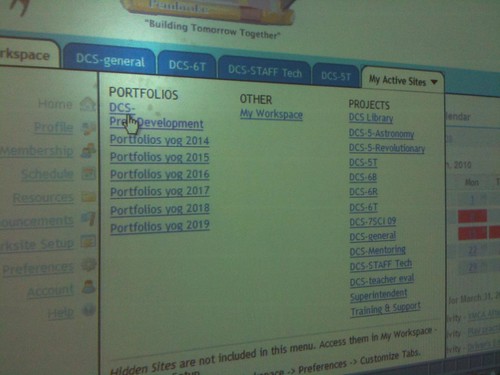Focus Question: How can teachers and students use digital portfolios as tools for learning?
A digital portfolio for a teacher is an individually prepared collection of work that communicates who a teacher is and what that teacher knows and is able to do in academic subjects and classroom teaching.

A standard-based digital portfolio serves as a way for new teacher candidates to connect lesson plans, teaching evaluations, and other work done in the classroom to the specific professional teaching standards they are required to meet in order to earn a teacher license. The advantages of digital portfolios include easy access, ready-made portability, creative information display, experience in developing technology skills, and the sharing of information with a wider educational community. The disadvantages of digital portfolios include the need for technical knowledge and skill, ongoing support, computer access, and time, as well as the possibility that style will override substance in the presentation of information.
I took a little tour of SurveryMonkey and I am quite fond of it. SurveyMonkey is an easy-to-use online survey tool with multiple ways to formulate questions and collect information. It allows one to choose their own layout, to input their own questions, and also to send your survey out to a select group of people. Along with allowing you to design your own survey, it also lets one collect the responses and when collected it also analyzes the results.
Summary & Conclusion

All in all, there are many ways that teachers and students can use digital portfolios as tools for learning. There are many ways that a teacher can allow students to view their progress over time. For example, when I was finishing up my observation hours I noticed the students keeping records of their AR scores in a folder since the beginning of their school year. I have also seen teachers keep flash drives with student work and compared the improvement overtime. It is truly an amazing tool for both teachers and students. It gives the students an inside look of their own achievement and also allows for parents to view the progress of their child
.
 Resources
Maloy, R. W., Verock-O, R. E., Edwards, S. A., & Woolf, B. P. (2010). Transforming learning with new technologies. Allyn & Bacon.
Resources
Maloy, R. W., Verock-O, R. E., Edwards, S. A., & Woolf, B. P. (2010). Transforming learning with new technologies. Allyn & Bacon.
 All in all, there are many ways that teachers and students can use digital portfolios as tools for learning. There are many ways that a teacher can allow students to view their progress over time. For example, when I was finishing up my observation hours I noticed the students keeping records of their AR scores in a folder since the beginning of their school year. I have also seen teachers keep flash drives with student work and compared the improvement overtime. It is truly an amazing tool for both teachers and students. It gives the students an inside look of their own achievement and also allows for parents to view the progress of their child.
All in all, there are many ways that teachers and students can use digital portfolios as tools for learning. There are many ways that a teacher can allow students to view their progress over time. For example, when I was finishing up my observation hours I noticed the students keeping records of their AR scores in a folder since the beginning of their school year. I have also seen teachers keep flash drives with student work and compared the improvement overtime. It is truly an amazing tool for both teachers and students. It gives the students an inside look of their own achievement and also allows for parents to view the progress of their child.  Resources
Resources
No comments:
Post a Comment